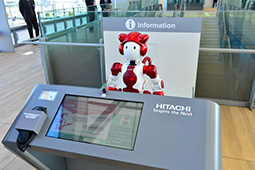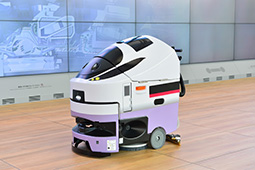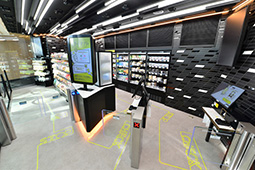INDEX
- English
- 日本語

New automated ticket gates introduced at the new station. (The gates don’t look much different from the outside, but the slanted IC card readers offer much improved convenience for children and wheelchair users.) - English
- 日本語

Takanawa Gateway Station has redesigned the conventional station concept.

The world’s first automated ticket gate system developed by Tateishi Electronics Co. (currently OMRON Corporation) was introduced in the Hankyu Railway at Kita-senri Station along the Hankyu Senri Line in 1967. 


Services based on cutting-edge technologies provided by Takanawa Gateway Station. (From top) AI-based guidance robots, a cleaning robot and an unstaffed store supporting AI-based payments (TOUCH TO GO).
June 2020
Gateway to a New Era

The automated ticket gate system was developed in 1967 to alleviate the congestion at train stations in Japan. The system has undergone a series of improvements in the years since, and in 2020 the latest iteration of the automated ticket gates appeared at a newly opened train station in Tokyo. The new station also operates as a model for the use of other cutting-edge technologies including AI-based guidance robots and security robots.

Takanawa Gateway Station, a new station on the JR Yamanote Line, opened this year in March. The new automated ticket gates called “Easy-to-touch automatic ticket gates” mount the location of the IC card readers at a slanted angle on the side of the gates to make them easier to use by children and passengers in wheelchairs. The gates are also equipped with a system that reads QR codes as part of a demonstration test. The station also offers new services based on cutting-edge technologies everywhere in the station such as AI-based guidance robots, security robots, cleaning robots and an unstaffed store enabling AI-based payment with approximately 600 types of products, and more.
Even though IC cards and automated ticket gates have become the norm now, they date back to automated ticket gates for magnetic tickets, implemented for the first time anywhere in the world by the Hankyu Railway at Kita-senri Station along the Hankyu Senri Line in 1967 during a period of high economic growth in Japan. As railway users increased, stations were crowded with so many commuters during the morning commute as station employees punched tickets with hole punchers. Tateishi Electronics Co. (currently OMRON Corporation) worked to solve this problem. They took six years to complete an automated ticket gate system. The technologies of this system initially spread slowly, but it rapidly spread after JR East introduced the system in 1991. This innovation was praised outside Japan, being recognized as an IEEE Milestone to honor significant achievements in the history of electrical, electronics and computer engineering in 2007 by the Institute of Electrical and Electronics Engineers.

Yagyu Hayato, Senior General Manager for the Development Center Social Solutions Business Headquarters of Omron Social Solutions Co., Ltd., which is in charge of automated gates in the Omron Group says, “I believe what underpinned the development was the hands-on approach of gaining a thorough understand of the situation in the field based on a strong desire to solve the morning and evening commuter rush, which had become a pressing social issue at the time.”
Yagyu explains, “Team members visited the station often, exhaustively studying the flow of passengers, their walking speed and the size of their luggage. This was before the dissemination of computers, so it was a time and labor intensive hands-on approach. Learning what was needed on-site and taking that insight back to the company to develop solutions through repeated prototyping and demonstration led to success.”
Later, the paper magnetic tickets developed into magnetic cards and IC cards.
It was FeliCa, a contactless IC card technology that could send data at high speeds developed by Sony, that led to the development of IC cards. IC cards rapidly spread across Japan when JR East adopted the FeliCa technology in 2001 for Suica, its IC card ticket. This technology then came to be used inside the station and around town, expanding to many uses, from a variety of passes to flight boarding passes, household appliances, and as electronic money.
Takanawa Gateway Station is looking for ways to further utilize these technologies.
If the utilization of the QR Codes currently undergoing demonstration testing advances to practical adoption in the future, it is expected to greatly improve the convenience for users, including visitors to Japan.
Fukasawa Yuji, president of JR East, emphasized the high point of the station by saying that he would hope passengers would be able to experience technology that allows them to imagine the future of train stations at Takanawa Gateway Station at a press conference held in December 2019.
Takanawa Gateway Station is five stations away from Tokyo Station and only one station away from Shinagawa Station. There, passengers will catch sight of a new style of station for the coming age, offering various new technologies all in an expansive space designed by the architect, Kuma Kengo.




